SNVS440B May 2007 – March 2016 LP5520
PRODUCTION DATA.
- 1 Features
- 2 Applications
- 3 Description
- 4 Revision History
- 5 Pin Configuration and Function
-
6 Specifications
- 6.1 Absolute Maximum Ratings
- 6.2 ESD Ratings
- 6.3 Recommended Operating Conditions
- 6.4 Thermal Information
- 6.5 Electrical Characteristics
- 6.6 RGB Driver Electrical Characteristics (ROUT, GOUT, BOUT Outputs)
- 6.7 Logic Interface Characteristics
- 6.8 Magnetic Boost DC-DC Converter Electrical Characteristics
- 6.9 I2C Timing Parameters
- 6.10 SPI Timing Requirements
- 6.11 Typical Characteristics
- 7 Detailed Description
- 8 Application and Implementation
- 9 Power Supply Recommendations
- 10Layout
- 11Device and Documentation Support
- 12Mechanical, Packaging, and Orderable Information
Package Options
Mechanical Data (Package|Pins)
- YZR|25
Thermal pad, mechanical data (Package|Pins)
Orderable Information
6 Specifications
6.1 Absolute Maximum Ratings
over operating free-air temperature range (unless otherwise noted)(1)(3)(2)| MIN | MAX | UNIT | ||
|---|---|---|---|---|
| V (SW, FB, ROUT, GOUT, BOUT) | –0.3 | 22 | V | |
| VDDA, VDDD, VDDIO, VLDO | –0.3 | 6 | V | |
| Voltage on logic pins | –0.3 V to VDDIO | 0.3 V with 6 V maximum | V | |
| Continuous power dissipation(4) | Internally limited | |||
| Junction temperature, TJ-MAX | 125 | °C | ||
| Storage temperature, Tstg | –65 | 150 | °C | |
(1) Stresses beyond those listed under Absolute Maximum Ratings may cause permanent damage to the device. These are stress ratings only, which do not imply functional operation of the device at these or any other conditions beyond those indicated under Recommended Operating Conditions. Exposure to absolute-maximum-rated conditions for extended periods may affect device reliability.
(2) If Military/Aerospace specified devices are required, contact the TI Sales Office/Distributors for availability and specifications.
(3) All voltages are with respect to the potential at the GND pins.
(4) Internal thermal shutdown circuitry protects the device from permanent damage. Thermal shutdown engages at TJ = 160°C (typical) and disengages at TJ = 140°C (typical).
6.2 ESD Ratings
| VALUE | UNIT | |||
|---|---|---|---|---|
| V(ESD) | Electrostatic discharge | Human-body model (HBM), per ANSI/ESDA/JEDEC JS-001(1) | ±2000 | V |
| Charged-device model (CDM), per JEDEC specification JESD22-C101(2) | ±200 | |||
(1) JEDEC document JEP155 states that 500-V HBM allows safe manufacturing with a standard ESD control process.
(2) JEDEC document JEP157 states that 250-V CDM allows safe manufacturing with a standard ESD control process.
6.3 Recommended Operating Conditions
over operating free-air temperature range (unless otherwise noted)(1)| MIN | MAX | UNIT | ||
|---|---|---|---|---|
| V (SW, FB, ROUT, GOUT, BOUT) | 0 | 21 | V | |
| VDDA,DDD | 2.9 | 5.5 | V | |
| VDDIO | 1.65 | VDDA | V | |
| Recommended load current (ROUT, GOUT, BOUT) per driver | 0 | 60 | mA | |
| Junction temperature, TJ | –30 | 125 | °C | |
| Ambient temperature, TA(2) | –30 | 85 | °C | |
(1) All voltages are with respect to the potential at the GND pins.
(2) In applications where high power dissipation and/or poor package thermal resistance is present, the maximum ambient temperature may have to be derated. Maximum ambient temperature (TA-MAX) is dependent on the maximum operating junction temperature (TJ-MAX-OP = 125°C), the maximum power dissipation of the device in the application (PD-MAX), and the junction-to ambient thermal resistance of the part/package in the application (RθJA), as given by the following equation: TA-MAX = TJ-MAX-OP – (RθJA × PD-MAX).
6.4 Thermal Information
| THERMAL METRIC(1) | LP5520 | UNIT | |
|---|---|---|---|
| YZR (DSBGA) | |||
| 25 PINS | |||
| RθJA | Junction-to-ambient thermal resistance | 58.2 | °C/W |
| RθJC(top) | Junction-to-case (top) thermal resistance | 0.3 | °C/W |
| RθJB | Junction-to-board thermal resistance | 7.9 | °C/W |
| ψJT | Junction-to-top characterization parameter | 0.5 | °C/W |
| ψJB | Junction-to-board characterization parameter | 7.9 | °C/W |
(1) For more information about traditional and new thermal metrics, see the Semiconductor and IC Package Thermal Metrics application report, SPRA953.
6.5 Electrical Characteristics
Unless otherwise noted typical limits are for TJ = 25°C, minimum and maximum limits apply over the operating ambient temperature range (–30°C < TJ < +85°C), and specifications apply to the LP5520 Functional Block Diagram with: CVDDA/D = 100 nF, COUT = 2 × 4.7 µF, 25 V, CIN= 10 µF, 6.3 V, L1 = 4.7 µH.(1)(2)(3)| PARAMETER | TEST CONDITIONS | MIN | TYP | MAX | UNIT | |
|---|---|---|---|---|---|---|
| IVDD | Standby supply current (VDDA + VDDD) |
NSTBY = L, VDDIO ≥ 1.65 V | 1.7 | 7 | µA | |
| NSTBY = L , VDDIO = 0 V | 1 | |||||
| No-boost supply current (VDDA + VDDD) |
NSTBY = H, EN_BOOST = L |
0.9 | mA | |||
| No-load supply current (VDDA + VDDD) |
NSTBY = H, EN_BOOST = H AUTOLOAD = L |
1.4 | ||||
| IVDDIO | VDDIO standby supply current | NSTBY = L | 1 | µA | ||
| VLDO | Internal LDO output voltage | VIN ≥ 2.9 V, TJ = 25°C | 2.77 | 2.80 | 2.84 | V |
| ILDO | Internal LDO output current | Current to external load | 1 | mA | ||
(1) All voltages are with respect to the potential at the GND pins.
(2) Minimum and maximum limits are specified by design, test or statistical analysis. Typical numbers represent the most likely norm.
(3) Low-ESR Surface-Mount Ceramic Capacitors (MLCCs) used in setting electrical characteristics.
6.6 RGB Driver Electrical Characteristics (ROUT, GOUT, BOUT Outputs)
Typical limits are for TJ = 25°C, minimum and maximum limits apply over the operating ambient temperature range(–30°C < TJ < +85°C); over operating free-air temperature range (unless otherwise noted).
| PARAMETER | TEST CONDITIONS | MIN | TYP | MAX | UNIT | |
|---|---|---|---|---|---|---|
| ILEAKAGE | ROUT, GOUT, BOUT pin leakage current | 0.1 | 1 | µA | ||
| IMAX | Maximum sink current | Outputs ROUT, GOUT, BOUT control = 255 (FFH) | 60 | mA | ||
| IR | Current accuracy of ROUT, GOUT, and BOUT | Output current set to 20 mA | 19 | 20 | 21 | mA |
| –5% | 5% | |||||
| Output current set to 60 mA | 54 | 60 | 66 | mA | ||
| –10% | 10% | |||||
| IMATCH | Matching(1) | Between ROUT, GOUT, BOUT at 20 mA current | ±0.2% | ±2% | ||
| tPWM | PWM cycle time | Accuracy proportional to internal clock frequency | 820 | µs | ||
| ƒRGB | RGB switching frequency | <pwm_fast> = 0 | 1.22 | kHz | ||
| <pwm_fast> = 1 | 19.52 | |||||
| VSAT | Saturation voltage(2) | I(LED) = 60 mA | 550 | mV | ||
| ƒMAX | External PWM maximum frequency | I(LED) = 60 mA, TJ = 25°C | 1 | MHz | ||
(1) Matching is the maximum difference from the average when all outputs are set to same current.
(2) Saturation voltage is defined as the voltage when the LED current has dropped 10% from the value measured at 2 V.
6.7 Logic Interface Characteristics
Typical limits are for TJ = 25°C, minimum and maximum limits apply over the operating ambient temperature range(–30°C < TJ < +85°C); over operating free-air temperature range (unless otherwise noted).
| PARAMETER | TEST CONDITIONS | MIN | TYP | MAX | UNIT | |
|---|---|---|---|---|---|---|
| LOGIC INPUTS SS, SI/A0, SCK/SCL, IFSEL, NRST, PWMR, PWMG, PWMB and BRC | ||||||
| VIL | Input low level | 0.2 × VDDIO | V | |||
| VIH | Input high level | 0.8 × VDDIO | V | |||
| II | Logic input current | −1 | 1 | µA | ||
| ƒSCK/SLC | Clock frequency | I2C mode | 0.4 | MHz | ||
| SPI mode, VDDIO > 1.8 V | 13 | |||||
| SPI mode, 1.65 V < VDDIO < 1.8 V | 5 | |||||
| LOGIC INPUT NRST | ||||||
| VIL | Input low level | 05 | V | |||
| VIH | Input high level | 1.2 | V | |||
| II | Logic input current | –1 | 1 | µA | ||
| tNRST | Reset pulse width | 10 | µs | |||
| LOGIC OUTPUT SO | ||||||
| VOL | Output low level | ISO = 3 mA VDDIO > 1.8 V |
0.3 | 0.5 | V | |
| ISO = 2 mA 1.65 V < VDDIO < 1.8 V |
0.3 | 0.5 | V | |||
| VOH | Output high level | ISO = –3 mA VDDIO > 1.8 V |
VDDIO − 0.5 | VDDIO − 0.3 | V | |
| ISO = –2 mA 1.65 V < VDDIO < 1.8 V |
VDDIO − 0.5 | VDDIO − 0.3 | V | |||
| IL | Output leakage current | VSO = 2.8 V | 1 | µA | ||
| LOGIC OUTPUT SDA | ||||||
| VOL | Output low level | ISDA = 3 mA | 0.3 | 0.5 | V | |
6.8 Magnetic Boost DC-DC Converter Electrical Characteristics
Typical limits are for TJ = 25°C, minimum and maximum limits apply over the operating ambient temperature range(–30°C < TJ < +85°C); over operating free-air temperature range (unless otherwise noted).
| PARAMETER | TEST CONDITIONS | MIN | TYP | MAX | UNIT | |
|---|---|---|---|---|---|---|
| ILOAD | Maximum continuous load current | 2.9V = VIN, VOUT = 20 V TJ = 25°C |
70 | mA | ||
| VOUT | Output voltage accuracy (FB pin) | 2.9 ≤ VIN ≤ 5.5 V, VOUT = 20 V TJ = 25°C |
–1.7% | 1.7% | ||
| 2.9 ≤ VIN ≤ 5.5 V, VOUT = 20 V | –5% | 5% | ||||
| RDSON | Switch ON resistance | ISW = 0.5 A | 0.3 | Ω | ||
| ƒPWM | Frequency accuracy | TJ = 25°C | −6% | ±3% | 6% | |
| –9% | 9% | |||||
| tPULSE | Switch pulse minimum width | no load | 50 | ns | ||
| tSTARTUP | Start-up time | 20 | ms | |||
| IMAX | SW pin current limit | 1100 | mA | |||
6.9 I2C Timing Parameters
VDD1,2 = 3 V to 4.5 V, VDDIO = 1.8 V To VDD1,2; see Figure 1.| MIN | MAX | UNIT | ||
|---|---|---|---|---|
| 1 | Hold time (repeated) START condition | 0.6 | µs | |
| 2 | Clock low time | 1.3 | µs | |
| 3 | Clock high time | 600 | ns | |
| 4 | Setup time for a repeated START condition | 600 | ns | |
| 5 | Data hold time (output direction, delay generated by LP5520) | 300 | 900 | ns |
| 5 | Data hold time (input direction, delay generated by Master) | 0 | 900 | ns |
| 6 | Data setup time | 100 | ns | |
| 7 | Rise time of SDA and SCL | 20 + 0.1Cb | 300 | ns |
| 8 | Fall time of SDA and SCL | 15 + 0.1Cb | 300 | ns |
| 9 | Setup time for STOP condition | 600 | ns | |
| 10 | Bus free time between a STOP and a START condition | 1.3 | µs | |
| Cb | Capacitive load for each bus line | 10 | 200 | pF |
6.10 SPI Timing Requirements
See Figure 2.| MIN | MAX | UNIT | ||
|---|---|---|---|---|
| 1 | Cycle time | 70 | ns | |
| 2 | Enable lead time | 35 | ns | |
| 3 | Enable lag time | 35 | ns | |
| 4 | Clock low time | 35 | ns | |
| 5 | Clock high time | 35 | ns | |
| 6 | Data setup time | 0 | ns | |
| 7 | Data hold time | 25 | ns | |
| 8 | Data access time | 30 | ns | |
| 9 | Disable time | 20 | ns | |
| 10 | Data valid | 40 | ns | |
| 11 | Data hold time | 0 | ns | |
 Figure 1. I2C Timing Diagram
Figure 1. I2C Timing Diagram
 Figure 2. SPI Timing Diagram
Figure 2. SPI Timing Diagram
6.11 Typical Characteristics
6.11.1 RGB Driver Typical Characteristics
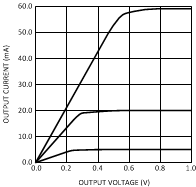 Figure 3. VSAT vs ILED
Figure 3. VSAT vs ILED
 Figure 4. VSAT vs ILED
Figure 4. VSAT vs ILED
6.11.2 Boost Converter Typical Characteristics
VIN = 3.6 V, VOUT = 15 V, if not otherwise stated.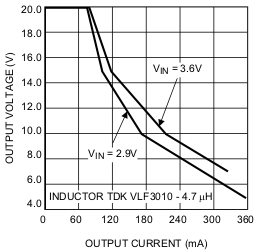 Figure 5. Boost Maximum Output Voltage vs Current
Figure 5. Boost Maximum Output Voltage vs Current
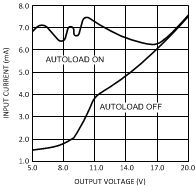 Figure 7. Auto-Load Effect on Input Current, No Load
Figure 7. Auto-Load Effect on Input Current, No Load
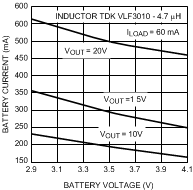 Figure 6. Battery Current vs Voltage
Figure 6. Battery Current vs Voltage
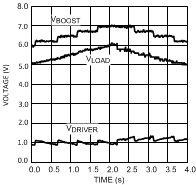 Figure 8. Adaptive Output Voltage Operation
Figure 8. Adaptive Output Voltage Operation